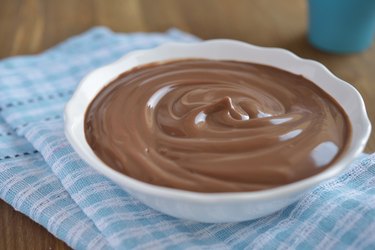
Soft, creamy puddings are an easy dessert to like, combining sweet, rich flavors with a cool and silky-soft texture. Most recipes use a starch thickener -- typically flour or cornstarch in the United States -- to bring the pudding to a suitable consistency. There are a number of alternative ways to thicken your puddings, so if you'd prefer to avoid corn and wheat, or to shun starches altogether, you still have choices.
Alternative Starch Method
Video of the Day
Step 1
Measure an alternative starch-based thickener, such as arrowroot powder, tapioca powder or rice starch, and combine it with the sugar called for in your pudding recipe. These alternative starches are comparable to cornstarch in thickening power, and twice as potent as wheat flour, so measure accordingly.
Video of the Day
Step 2
Stir the thickener into the sugar until well combined, then combine them with the remaining dry ingredients. Whisk the dry and wet ingredients together, then bring the pudding to a simmer over low to medium heat.
Step 3
Simmer the mixture gently, stirring often, until it thickens. Pour the pudding into a serving bowl or individual ramekins, and let it cool.
Gelatin Method
Step 1
Prepare the pudding according to your favorite recipe, except for the starch thickener. Bring the ingredients to a gentle simmer, stirring frequently so the milk doesn't stick to the bottom of your saucepan and scorch.
Step 2
Measure out 3/4 teaspoon of unflavored gelatin for every cup of milk or cream in your pudding. This will set it gently, without creating the characteristically rubbery texture associated with gelatin.
Step 3
Spoon 1 tablespoon of cold water into a small bowl or measuring cup, or every cup of milk or cream in your pudding. Sprinkle the powdered gelatin over the cold water and let it rest for 2 to 3 minutes, until the granules have absorbed the water and become evenly plump and swollen.
Step 4
Heat the gelatin in your microwave, in 15-second increments, until it's hot and completely melted. Pour the pudding through a fine-mesh strainer into a mixing bowl, to remove any lumps of flavorings or granules of overcooked egg. Whisk the melted gelatin into the pudding mixture, until it's completely dissolved.
Step 5
Pour the finished pudding into a serving bowl or individual dishes, and chill it until the gelatin sets.
Using Irish Moss
Step 1
Rehydrate 1/2 cup of firmly packed dried Irish moss in cold water for 15 minutes, then squeeze out the excess moisture. This is adequate for 3 cups of milk or cream, a common batch size for puddings. If you're using fresh Irish moss, use 1 full cup of the fresh seaweed to achieve the same thickening effect.
Step 2
Add the moss to your milk or cream and simmer it gently in the top of a double boiler, or in a mixing bowl set over the top of a saucepan of boiling water. Cook the seaweed in your cream for 25 to 30 minutes, stirring occasionally.
Step 3
Pour the milk through a colander lined with several layers of cheesecloth, to remove the Irish moss. Squeeze gently to get out as much milk as you can, then discard the seaweed.
Step 4
Stir your flavorings into the heated cream, then pour the mixture into molds or individual dessert dishes. Refrigerate the puddings until they've set.
Things You'll Need
Arrowroot, tapioca, rice starch or other thickener
Sugar
Milk or cream
Vanilla and other flavorings
Mixing bowl
Whisk
Serving bowl or individual dessert dishes
Saucepan
Measuring cup
Cheesecloth
Colander
Tip
Be sure you've purchased rice starch, rather than rice flour. Rice flour can be rather coarse and isn't an especially effective thickener, while rice starch is both a powerful thickening agent and the finest-textured of them all.
Irish moss is a seaweed that grows wild along parts of the East Coast, and is available from online suppliers and some gourmet shops. The active ingredient in Irish moss is carageenan, a thickener used widely in nutritional shakes, chocolate milk, ice cream and other foods. Like agar-agar, another seaweed extract used as a gelling agent, it's suitable for vegetarian and vegan diets.